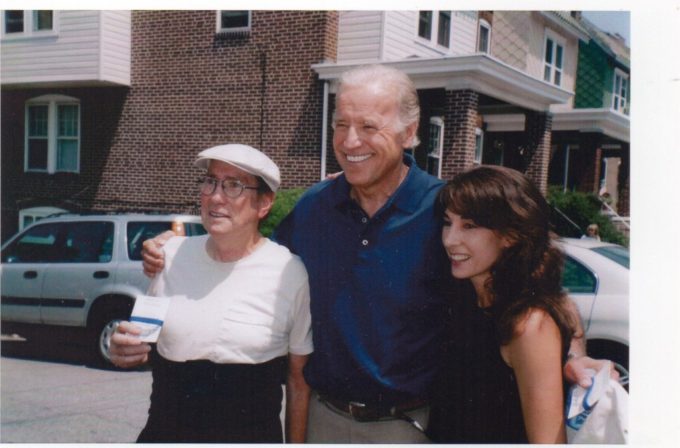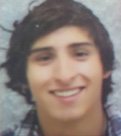Mesothelioma Help Cancer News

My Hero
by Samantha Robeson
A yellow Post-It note is stuck over his mouth with a drawing of a huge smile on it; a furry stuffed hedgehog sits precariously on top of his head. Memories of my Poppop always bring a smile to my face. The side effects from the medication of the latest clinical trial didn’t make Poppop’s hair fall out, but it made it curly and wiry. He called himself Brillo Head and would make his grandkids giggle by using our stuffed animals as his wigs. Poppop always had a smile on his face; if the pain was too bad or if he was too weak to smile, he would draw one on his face so that we knew he was still happy inside. He wasn’t just a survivor; he was so much more to all of those who had the pleasure of being in his presence. Nobody knows how he could stay so positive for so long in the face of such pain and suffering. When he was hurting so badly that he couldn’t hide the anguish, he would hide from his loved ones so as not to upset them. It sounds cliché to say that my Poppop was such an inspiration, but it is hard to put into words how his charisma and optimism touched those around him. He was my hero.


The oncologist explained that the procedure done by the pulmonologist (partial decortication) severely limited Poppop’s later treatment options such as a pleurectomy or pneumonectomy. Also, one of Poppop’s ribs was broken during the surgery; the severe pain was from the nerve bundle that was then trapped. Surgery to fix the rib was not recommended due to the spreading cancer. The oncologist told Poppop that he had 6 months to live, and since chemotherapy would not cure the cancer he wouldn’t recommend any treatments. He suggested that Poppop get his affairs in order. If this were me, I would be ticked off at the asbestos companies and the pulmonologist who told me I didn’t have cancer. Not Poppop—he never worried about himself, because he was too busy caring about Mommom, his four kids and us 10 grandchildren. He wasn’t going to let this death sentence kill his spirit.
Poppop was only 60 years old; how could he have only 6 months left to live? We spent every weekend with him in the summer, when the family would crowd into his little trailor at the beach to enjoy each other’s company. He was just chasing me around with a live crab saying it was going to bite my nose. Poppop was the one who took care of everything for everybody; he fixed everyone’s toilets, heaters, cars, boats and he even knew how to fix broken hearts with a smile. Poppop would make sure everyone else’s problems were fixed before he tended to his own leaky faucet. What would we do without our Poppop? Everything would fall apart and no one would laugh ever again!
Have no fear, Poppop is here to put a smile back on everyone’s face. He wasn’t going to let a little cancer destroy his family. He would joke with all of saying “Meeezofeeeleeeheeemeeesheemeeomia– how could something with such a goofy name be so scary?” Comic relief was our saving grace when Poppop was around. My mom tried not to let us kids see her cry, but I remember how she didn’t go to sleep for days because she was doing research to find some ray of hope. Finally, she found a story about a man with mesothelioma who was involved in a clinical trial and was beating the odds. Within days, Poppop was on the phone with this survivor, and my mother had used a ream of paper printing out information about the clinical trials for people with mesothelioma.
Poppop’s 6 month death sentence turned into a 6 year stay. He looked at each day as a gift, and he taught us to be grateful rather than resentful. While participating in the various clinical trials, Poppop spoke to newly diagnosed patients who had no idea what they should do next. Naturally, he found a way to make even the sickest people smile. Mommom would tell us stories about Poppop’s antics when he was getting his treatments with the other cancer patients; his silly jokes would make not only the other patients but also the medical staff crack up. In addition to being a great support to other cancer patients and their families, he also educated others by talking to various community, medical and labor groups. In 2005, the Graham Cancer Center (Delaware) awarded my Poppop with the “Community Excellence Service Award” for reaching out to help others.
My Poppop also helped to raise awareness about Mesothelioma at the federal level, but that was no easy task. He never gave up; he wrote letters until the officials agreed to meet with him, he took multiple trips to Washington D.C., and he would track down our state officials at every carnival and parade they attended. Senator Joseph Biden (who is now our Vice President), replied to every letter, met with my father and wore the blue Mesothelioma Awareness bracelet my father and mother gave him. When I look at the picture of my Poppop talking with Representative Michael Castle about mesothelioma, it is hard for me to believe that less than 4 months later he took his last breath. My Poppop had to wear a tight band wrapped around him and suck on pain lozenges, but this didn’t stop him from spreading awareness. (see the attached photos)
A month after my Poppop was laid to rest, my Mommom was mailing information to the government officials with a cover letter stating, “My husband died from mesothelioma…He was in the process of writing the attached letter when his cancer became very aggressive, so he was never able to mail it. Since he was diagnosed with mesothelioma six years ago, his main concern has been to inform the public…Before he died I promised him that the letter would be mailed. Please take a few minutes to read it.” Years after his passing, we continue to spread awareness in his memory; along with my mother, brother and Mommom, I went to Washington D.C. and was able to share our family story with those on Capitol Hill. I wish my Poppop could have been at my high school graduation and could see how hard I am working in college, but instead of being sad, I feel joy that he was an important part of my life. Hopefully one day, I’ll become a Bio-Medical Engineer who helps to develop treatment options that enable those with cancer to write their own personal survival story.
About





Haider F. Zahabi
By: Haider F. Zahabi
As a child growing up in Iraq, I lived through the end of the Iran and Iraq war as well as the American and Iraq war. I can remember seeing buildings and cars blown up on a daily basis. I can remember the dust and debris from these buildings that filled the air. I remember the thick smoke from burning oil refineries that made breathing nearly impossible. As I grew I began to see more and more people getting sick. I saw many older men and women coughing and having trouble breathing even when the air seemed clear. I observed people walking around in pain and suffering. I figured they were getting old. As an adult, I discovered that these people were not just getting old but in fact were very sick. These people were among the thousands of people who are sick from mesothelioma and other cancers caused by such materials as asbestos.
During geology class I learned that asbestos is a naturally occurring substance that is processed into a fire resistant fibrous structure with great thermal insulation properties and high tensile strength that many manufacturers and home builders liked to use. Many builders used asbestos in floor tiles, insulation, shingles, cement and many other items used in home construction in Iraq. It was the asbestos in the building materials that were making many of the Iraqis I saw sick. When the buildings and structures they lived in or around were destroyed from bombings, the deadly asbestos became airborne. The people would walk around inhaling the deadly asbestos fibers. Many of these people were unaware that something as simple as breathing would kill them later. As people aged the fibers that embedded themselves in the lungs of these innocent people began to make them sick. The worst part is it was not just older people that were getting sick; it was middle age adults like my best friend’s uncle who was only 40 years old. What I realized was many people died and are getting sick because builders and manufacturers did not and will not stop using such materials such as asbestos despite knowing the dangers. This knowledge pushed me to go to school to get an education in which I could make a difference. I knew I could not be a doctor or a scientist but I knew I could be an engineer and work to make safe options for people.
While I cannot change the past, I can continue my education, help educate the future and raise awareness of the deadly effects of asbestos and other carcinogens. I want to educate Americans and other countries that have lax building codes and manufacturing regulations. People all over the world deserve to be educated and made aware of the dangers. They need to understand how to protect themselves. Furthermore, by becoming an engineer, I can ensure that the company I work for considers the effects these chemicals and materials have on people. I want to be able to look at the people who utilize my products or inhabit the buildings I help build. I do not ever want to know that I cut corners and saved money at the risk of someone’s health. Finally I want to be able to tell people who are suffering and their families that I will work hard to ensure that future generations will not have to experience what they have. I want them to know that I will fight for them.
Overall mesothelioma is a preventable disease that my country men and others should never have to experience. This disease can be eradicated through education and the institution of laws to protect the innocent. I do not want people to be afraid of the materials in their house. Additionally I want to see restrictions implemented in America, Iraq and other countries that have failed to protect their people. Furthermore I want people to understand how devastating a disease like mesothelioma is to families. The public needs to understand that watching a family member suffer through a preventable disease is not only heartbreaking but devastating.
To all people who are suffering or is a family member of someone who is suffering I would say, keep your head up. I cannot say that I personally know what you are going through but know there are people out there who care and will fight for you and your rights. I, along with many others, will work to improve laws that can help prevent this from happening again. Finally I would say you are in my prayers and will be there for you.
About


My name is Haider Zahabi and I am from Baghdad, Iraq. I moved to the United States in 2012 and currently live in Houston, Texas. I have been working to get my Bachelor’s Degree in Mechanical Engineering since 2013. In Iraq I worked with the U.S. military as an Interpreter in order to help build a positive relationship between Iraqis and Americans. I plan on getting my degree and making a positive impact in the world!!


My grandfather, Jim Shiffer
by Justin Hellier
Full bodied screams filled the hospital hallways. My grandfather, Jim Shiffer, was dead. Mesothelioma had ravaged his body for over two years, and the battle that had left the heart in my family torn was finally over.
Jim Shiffer was a strapping man who could lift more than most 20-somethings at the age of 70. He was an accomplished painter with dozens of paintings of famous vacation spots around the world hung up on his walls, all of which he had seen and experienced with his own eyes. His most notable accomplishment was rising to become the president of Pacific Gas and Electric Company where he oversaw thousands of engineers. After a lifetime of hard work, he was able to retire, which gave him more time to focus on what was always a priority to him: family. He planned all of the family gatherings and brought everyone closer to each other. He is the only reason I was able to spend so much time with all of my aunts and uncles during the holidays making memories that will last forever. His passion for golfing was taken to the next level, making 2nd place a solid standing for anyone who played a round of golf with him. My grandmother talked about Jim constantly and loved everything about him, from the nonstop traveling to the intimate conversations they would have. Jim was a caring man that everyone looked up to, but every great thing must come to an end.
On Thanksgiving of 2011, my grandfather was taken to the hospital due to his erratic coughing. The doctors found 2 liters of cloudy fluid in his lungs and drained it out that night. He had to wait three days for the doctor diagnosis. They told him that he had a terminal cancer called mesothelioma. Asbestos is the only thing known to cause this type of cancer and it didn’t take long to realize where he had been exposed to it. The very thing he spent his whole life climbing to achieve was the very thing that ended his life. During his time working at power plants in the 70’s and 80’s, he worked in asbestos-filled areas. PG&E was using asbestos as insulation and twenty years of breathing it lead to the formation of cancer cells. The doctor only gave him three to six months to live. Jim’s father lived to be 98 years old and in that very moment, 20 years of plans to travel, golf, and spend time with the people he loved, was reduced to enough time to plan a funeral.
With little time left, Jim spent most of it making sure his family was taken care of and that my grandma was able to support herself. With his spare time, he managed to keep up most of his hobbies and lived as if cancer wasn’t spreading through his body. But time passed and he began to feel the effects. Chemotherapy only seemed to harm his body even more and with every treatment came days of nausea and pain. Even though he wasn’t given long to live, he manage to fight his way to live for two year longer then the doctors said. As the cancer grew, Jim grew weaker. His days playing golf were replaced with lying on the couch and his clubs were replaced with an oxygen tank. In the end, everything he loved to do was stripped from him and the inevitable happened. On March 20, 2014, as Jim Shiffer passed away, my grandmother realized that no matter how long you prepare, nothing can compare to the reality. Her cries were heard through the whole hospital and the doctors calmed her down with drugs. That was the end.
A settlement was made for people like Jim that were exposed to asbestos in the work area due to the careless actions of contractors and subcontractors. A portion of the settlement has been given to my grandma, and she is able to live well and has paid off all of the medical bills. Even after his death, Grandpa Jim still had one last lesson to teach me: No matter how much money we got from the settlement, he was never going to come back. Mesothelioma is serious and no one should have to go through what my family and numerous families around the world have had to go through. This cancer can be stopped and people everywhere are making sure that it does get stopped. I respect every person that makes choices to get rid of asbestos and I know that one day no one will have to suffer from mesothelioma needlessly.
About




My Frank
Before I met Frank, my knowledge of mesothelioma was restricted to the half-minute ad spots between old Jeopardy reruns that all seemed to be bought by hordes of law firms with tough-sounding names. Frank and I always watched Jeopardy together in his assisted living community and he always knew the answers to the most obscure trivia, a glint in his eye when he knew the Final Jeopardy answer I didn’t. Mesothelioma was to me, before the diagnosis, just another long word; another disease that seemed so foreign and ethereal. After the diagnosis, it was the scariest word in my vocabulary.
Frank had been complaining of tightness and difficulty breathing for weeks, but I figured it was just the cold snap we were having. Frank’s children were grown and lived across the country, so I took him to the hospital and we watched Trebek shake the hands of the winning contestant on the silent monitor as we waited for his doctor to give him his examination. Later that night, Frank called me to tell me the doctor had ordered an x-ray. I was surprised but Frank, with his characteristic Navy gruffness, said he wasn’t worried and asked if I’d give him a ride.
I was in class when I got the call. Frank would never call me during class saying, “You need to be in class in case you get a clue you can use in Jeopardy”, laughing with his eyes. I instantly knew something was the matter. He sounded so distant, so small. He said the doctor had seen something in his lungs, that they’d scheduled a biopsy for later that week, and if I would mind giving him a ride. The next few days were a blur. I thought the not knowing was the worst part, I know that it killed him to be so out of the loop. Honestly, it was not.
When Frank spoke the words, “pleural mesothelioma” I was relieved. Finally, we had an answer and could begin to tackle the disease. That night I did what any good Jeopardycontestant would do, I looked up as much as I could on mesothelioma on the internet. I will never forget the way I felt that night as I read; the deeper I investigated, the deeper the pit in my stomach grew. I wanted to run, I wanted to get away somehow, it was the first time I encountered despair.
Mesothelioma is a paradox. It is an extremely rare cancer caused by an extremely common material, asbestos, naturally occurring fibrous minerals found in certain types of rock formations. Asbestos has been used by humanity for decades because it is fire resistant and impervious to the elements; the ancient Egyptians even used it to wrap their mummies. It was this same material that was in my best friends’ lungs, suffocating him as it threatened to sarcophagize him. I remember looking up the asbestos molecules and seeing what looked like a cluster of tiny crystals, beautiful and deadly barbs that I knew were responsible for Frank’s condition. My mental anguish intensified as I saw that online there were mostly only support groups for mesothelioma and not a lot of treatments.
The median 5-year survival rate of people with mesothelioma is 5% according to the NIH SEER program. I couldn’t grasp this then, and I still can’t grasp it now. How do you measure 5% of a life? If you took 5% of all the laughs he shared, 5% of all the old Navy stories he had, 5% of every Jeopardy question he answered it’s still not enough to convey the magnitude of his being. I got very sad thinking about my friend’s fate.
Then, I got angry. Why him? Where did it come from? How was he exposed?
Asbestos in the United States has a long and troubling history. Since the industrial revolution and the advent of mechanized mining of asbestos, asbestos has been used in many commercial applications like insulation for pipes, wiring, and buildings. When the United States started taking the position as a world power, it increased its dependence on this deadly material. Hundreds of tons were used to insulate ships, war planes, and command centers throughout our history of conflicts from WWI to Vietnam. Asbestos activity is not limited to our activities abroad, but it has been used in roofing, housing insulation, even the very ceiling tiles over your head right now. Asbestos is everywhere and it is deadly. As for Frank, I’ve come to terms with the fact that I’ll never know where he was exposed. He was in Vietnam, but he also came home to work in construction, both very high risk occupational areas as far as asbestos exposure is concerned.
Frank was diagnosed with stage IV pleural mesothelioma and given only a year to live. He didn’t make it, but he fought hard. I remember when I asked him what he was going to do about it he told me he was going to play it like Final Jeopardy, “Wager big, and hope to God I know the answer.” He did wager big. He took on very heavy chemotherapy to try to kill the cancer. Towards the end of his life, through exhausting treatments, crippling nausea, and incredible wasting we would share his jell-o cups and sit in his room watching Jeopardy. As I looked over at him, too tired to get out of bed or even eat, I could still see that incredible mind at work and see that same glint in his eye as he answered Final Jeopardy. This is how I choose to remember him.
Works Cited
Centers for Disease Control. “Health Effects of Asbestos.” ATSDR. Centers for Disease Control. Web. 05 Oct. 2014.
http://www.atsdr.cdc.gov/asbestos/asbestos/health_effects/
“Education.” ADAO Asbestos Disease Awareness Organization. Web. 07 Oct. 2014.
EPA. “Asbestos.” Asbestos. Web. 05 Oct. 2014.
http://www2.epa.gov/asbestos
The Lancet. “Asbestos-related Disease: A Preventable Burden.” Asbestos Related Disease:a Preventable Burden. The Lancet. Web. 06 Oct. 2014.
http://secure.jbs.elsevierhealth.com/action/cookieAbsent
National Institutes of Health. “Asbestos: MedlinePlus.” U.S National Library of Medicine. U.S. National Library of Medicine. Web. 07 Oct. 2014.
https://www.nlm.nih.gov/medlineplus/asbestos.html
Occupational Safety and Health Administration. Asbestos Fact Sheet. OSHA. OSHA Asbestos Fact Sheet. Web. 6 Oct. 2014.
https://www.osha.gov/Publications/OSHA3507.pdf
Spirtas, Robert, Roger R. Connelly, and Margaret A. Tucker. “Survival Patterns for Malignant Mesothelioma: The Seer Experience.” International Journal of Cancer 41.4 (1988): 525-30. Web. 6 Oct. 2014.
About




My Envisioned Medical Practice: Treatment of Mrs. Laura Hill
This morning, I have a new patient. She is a 64-year-old retired teacher named Laura Hill and the referral from her PCP says she complains of shortness or breath, chest pain, and coughing. I pull out my stethoscope and warn Mrs. Hill that it might be a little cold as I begin checking her breathing.
As I examine Mrs. Hill, she says “Please call me Laura,” and tells me she retired just last year after working in the same elementary school for 35 years. Laura tells me how much she misses the children at school, but that she just was unable to keep up like she used to. “I’m ready to start taking tropical vacations with her husband and spend time with her six grandchildren!” she exclaims. My patient knows she’s in the office of an oncologist and is definitely expecting the worst. I let her know her breathing is a little irregular and that we will have to get an ultrasound. She seems concerned but hopeful.
Two days later, when the ultrasound results indicate a malignant formation on Laura’s left lung, she asks me what we can do. I inform her immediately that cancer isn’t something anyone should try to battle alone and that she should rely on family for help. I stress the fact that psychological support is 50% of the battle. I gently let her know that pleural mesotheliomas have a poor prognosis- about a year- but that there are several options. I try to make Laura as informed as possible, both verbally, but also on paper, because I understand news like this doesn’t make it easy to remember things. First of all, I explain to her how cancer works, keeping in mind that she might be unfamiliar with some of these scientific concepts. I proceed to tell her about the standard and non-standard therapies.
I explain to Laura that standard medical care for mesothelioma includes surgery and chemotherapy, potentially as well as various other drugs, but because of the placement of her tumor near the spine, surgery is dangerous and because of the poor mesothelioma prognosis, chemotherapy would decrease her quality of life without significantly prolonging it. “Well what’s the point in trying to be ‘standard’ if none of that will work for me,” she asks. I proceed with the alternative therapies.
I inform her first and foremost that these next few options are not FDA approved, but have still proven effective in some cases. Laura asks, “Why do people try these if they aren’t approved.., It seems like I don’t have any chance of fighting this thing either way.” I quickly tell her not to give up so quickly and I explain that many people, including a patient, James Rhio O’Connor, who practiced these non-traditional methods and actually lived more than six years past his prognosis. I teach Laura about complementary methods that are used with the standard ones, such as acupuncture or acupressure and about alternative medicine, which has been used instead of standard medicine and has been heavily based on mind-body medicine. Laura asks me to elaborate
and I tell her that there are several, though not many, clinical trials testing these methods, including music therapy, fish oil, pomegranate, tangerine, and yoga.
“Well, what do you think I should do,” Laura inquires. I tell her that she should chose what she is most comfortable with because she is the one undergoing the treatment and coping with the disease. I continue that though there have been more studies conducted for standard medicine therapies, there have also been success stories with traditional medicinal and folk medicine. “Laura, I will give you all the information necessary so we can make a treatment plan together along with your primary care doctor and family,” I express.
We continue our discussion. When Laura asks why there is a lack of research for alternative therapies I tell her that there is a lack of funding, time, and institutions who are willing to conduct this work. She asks me if it has to do with money. “Doesn’t it usually,” I reply. I mention to her how it costs nearly $400 million to bring a new cancer drug to the market, whereas natural medicine is difficult to patent and therefore tough to make money from. Laura disapprovingly shakes her head and tells me “I want to do it the natural way. Humans were able to be healthy long before pharmaceutical companies were invented and I want to try that, but I have a feeling my insurance will frown on that.” I tell her that insurance companies are actually starting to accept more of these non-standard cancer treatment methods, but that it is certainly something that could be improved in our healthcare system. I go to my computer and print out for Laura a few articles from scientific journals that stress the importance of nutrition in the diet.
The next day, she comes in with her primary care physician and husband and the four of us sit down together and go through her treatment plan. “I’m actually feeling quite hopeful about this,” she says with a slight smile. I think to myself what an amazing attitude this woman has had. We all agree that she will maintain a mostly vegetarian diet that will be supplemented with vitamins, minerals, essential amino acids, fatty acids, and enzymes, which her PCP and I had found in our research the prior evening. After answering Laura and Mr. Hill’s questions, I stand up to open the door for them. Laura hugs me and confidently says, “You say months… I say years.”
About


I am very excited to graduate from the University of Pittsburgh and start an inspiring career in medicine! My goal is to ultimately practice medicine in a predominantly African American residentially segregated area. These neighborhoods are often plagued by old housing that contains asbestos, so garnering a comprehention of mesothelioma and its potential medical cares is crucial for me. I thank Mesotheliomahelp.org for this opportunity and I look forward to continuing my education about cancer for a lifetime to come.


Free Mesothelioma Patient & Treatment Guide
We’d like to offer you our in-depth guide, “A Patient’s Guide to Mesothelioma,” absolutely free of charge.
It contains a wealth of information and resources to help you better understand the condition, choose (and afford) appropriate treatment, and exercise your legal right to compensation.
Download Now